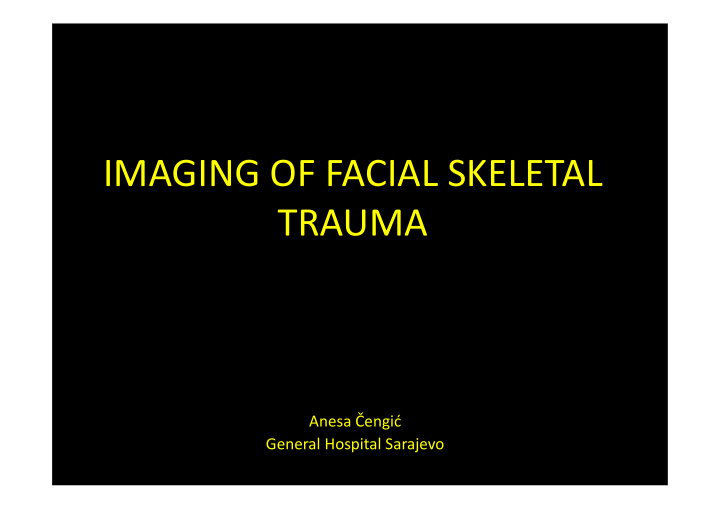



IMAGING OF FACIAL SKELETAL TRAUMA Anesa Čengić General Hospital Sarajevo
FACIAL FRACTURES Facial fractures are commonly caused by blunt or penetrating trauma due to motor vehicle accidents, work and sport related injuries, assaults, and falls. Analysis of the fractured face requires a knowledge of not only normal anatomy, but also of common fracture patterns in the face.
FACIAL TRAUMA EVALUATION • X-ray overrated • Isolated nasal or zygomatic arch fx • Hazzy sinuses, lines of Dolan • CT imaging modality of choice • Easier to perform in multitrauma patients and non-cooprative patients • If you think of injury other then simple nasal fracture
Examination technique • 0.6 mm axial multi-detector scan acquisition • Axial scaning from above the frontal sinus down to below hard palate, can include mandibule if there is a clinical suspition for fracture • Coronal 1 mm reformats • Bone and soft tissue window, 3D imaging
Aim of imaging • Fracture lines, Bony displacements • Soft tissue injuries • Organize by compartments or butresses • Categorize the fracture type • Intracranial complication
Facial anatomy
• Buttresses are all linked either directly or through another buttress to the cranium or cranial base as a stable reference point. • Buttresses have sufficient bone thickness to accommodate metal screw fixation. • Transverse buttress reduction restores facial profile and width; vertical buttress reduction restores facial height. • Buttress reduction establishes a functional support for the teeth and globes.
Frontal sinus • Anterior wall, Posterior wall, Both • Displacement and comminution Posterior wall fracture • Pneumochephalus • Dural violation • Degree of bone lose
Nasal bone fractures • Most common facial fracture • Blunt force applied from anterior or lateral direction • Fracture extension into the nasal cartilage may disrupt the perichondrium causing sepatal hematoma
Nasal bone fractures
Fractures of the naso-orbitoethmoid (NOE) complex • High-impact force applied anteriorly to nose • Severe comminution of both medial maxillary buttresses ( nasal bones and septum, ethmoid sinuses, medial orbital wall ) • Spares lateral butresses
Markowitz / Manson classification
Zygomaticomaxillary complex fracture • quadripod fx • Direct traumatic blow to malar eminence • Dissociation of zygomatic bone from calvaria • Associated orbital injuries 33% of cases
Medial or lateral rotation of zygomatic bone?
ZMC FX
Le Fort fractures
Le Fort fractures 1. Pterygoid plates (intact of fractured) 2. Pterygomaxillary disjunction Classify the fractures I. Lateral piriform aperture II. Inferior orbital rim and zygomaticomaxillary suture III. Zygomatic arch+lateral orbital wall
Orbital „blowout“ fractures • Trauma caused by large object that cannot enter the orbit • Orbital rim remains intact • Orbital wall is fractured • Complication: muscule herniation and entrapment, globe injury, infraorbital nerve injury
Mandibular fractures
Mandibular fractures • Fractures occurs in multiple location • Ring-like structure typically produces at least two discreate fractures • Plain ortopantogram should not be used as a single modality for mandibular fractures
Mandibular fractures
Mandibular fractures
Conclusion Summary • CT imaging modality of choice • Group facial fractures into clinically relevant patterns • Provide clinically relevant radiology report • Cooperate and discuss with surgeon
Recommend
More recommend